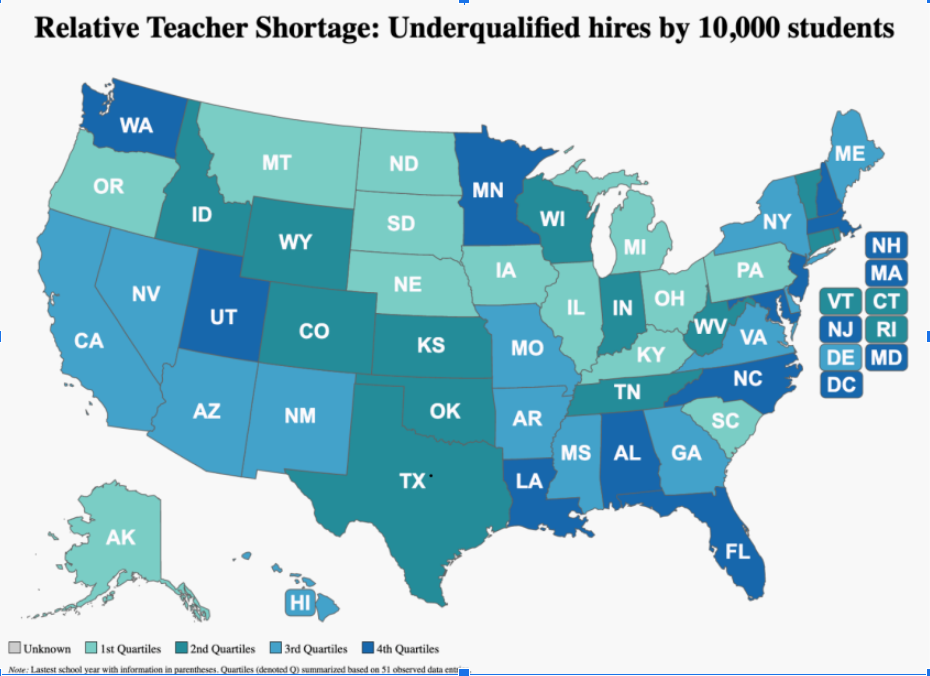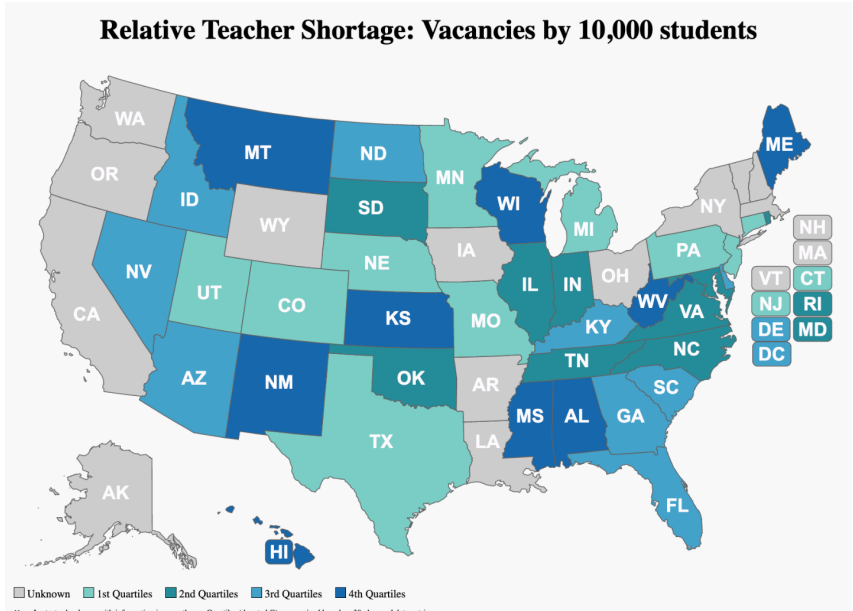Teacher shortages have become a critical issue across the United States. According to a 2022 report by the U.S. Department of Education, 41 states and D.C. are facing shortages in at least one subject area or grade level. The COVID-19 pandemic worsened the teacher shortage situation—necessitating immediate action to address the growing crisis in the education sector.
The U.S. Department of Education defines teacher shortage in 3 ways:
- Unfilled positions
- Positions filled by under-qualified teachers
- Positions filled by teachers in a different subject than their certification
Current estimates are increasingly alarming:
Over 365,000 teaching posts are filled by teachers who are not fully certified, and an additional 45,500 positions remain unfilled—bringing the total to at least 411,500 impacted positions nationwide (about 1 in 8 teaching roles). This figure represents a rise of approximately 4,600 since last year. Additional data show:
- More than 40% of schools report having to hire underqualified teachers, nearly 30% have increased class sizes, and 25% have cut course offerings due to staffing shortages.
- Teacher turnover is climbing: in a sample of eight states, turnover rates jumped to 14%–16% in 2023–24, about 2 percentage points higher than pre-pandemic years.
Nationwide Challenges
There is debate on whether it’s a national shortage or uneven distribution of teachers. A comprehensive study on teacher shortage by the Annenberg Brown University classifies teacher shortage based on the availability of data on teacher vacancies.
Some states have clear teacher vacancy data. E.g., at the time of the study, states with the highest vacancies include Florida (3,911), Illinois (1,703), and Arizona (1,699). The states with lower vacancies included Utah (37), Missouri (38) and Nebraska (42). Other states like Georgia and Alabama had unclear data, while some states like Massachusetts, Oregon, and Washington lacked actual data on vacancy numbers. This made it difficult for the study to determine the national scope of the teacher shortage problem.

But, even a conservative approach, places the teacher shortage to close to 40,000, signifying the need for an immediate solution. In fact, 86% of public schools struggle to hire educators.
The shortage is particularly acute in STEM fields and foreign languages.
Is there any cause for the perennial teacher shortage? Yes! A survey by NORC at the University of Chicago found only a dismal 18% of Americans would encourage young people to become K-12 teachers.
The study cites low pay, lack of resources, and a stressful work environment as the main demotivators to joining the teaching career. For instance, the average annual salary for teachers in the U.S. was $68,000 as of October 2023, which is 8% less than the average salary for all workers in the country. And, teacher salaries have grown more slowly than pay in other sectors.
Here are different innovative solutions different states are employing to deal with teacher shortages:
Florida- Leading the Nation in Teacher Demand
Florida – Leading the Nation in Teacher Demand (Updated Mid-2025)
Florida continues to confront a significant teacher shortage, though recent figures show improvement. For the 2025–2026 school year, the Florida Department of Education reports a 17.7% reduction in vacancies compared to the prior year, representing a nearly 30% decrease over the last two years, down from more than 7,000 vacancies in 2023 to about 3,000 by early 2025. However, the Florida Education Association (FEA) warns that many classrooms still lack certified, permanent teachers, attributing the decline not only to improved hiring but also to budget cuts and reductions in staffing that lean heavily on uncertified educators
“Florida is dealing with, if not the worst, one of the worst teacher shortage situations in the nation.” — Andrew Spar, President of the Florida Education Association, 2023.
Underlying the ongoing shortage are enduring issues like low teacher pay, long hours, and political interference.
“Teachers are not encouraging other people to become teachers because they know how bad it is,” said Chris Pagel, president of the Nassau Teachers Association.
Efforts to counter the shortage are underway. Florida has allocated over $5.9 billion toward pay increases, launched programs like the Teacher Apprenticeship Program, expanded eligibility for veteran certification pathways, offered signing bonuses, and introduced awards like the Teacher of the Year, with prizes ranging from $10,000–$50,000 Despite the progress, Florida no longer leads the nation in vacancies per 10,000 students. That distinction now belongs to West Virginia, which reports around 39 vacancies per 10,000 students, compared to Florida’s 14 per 10,000
Texas- Addressing the Shortage with Innovative Solutions
San Antonio is exploring a teacher homebuyer incentive program to help retain educators. Proposed by District 2 City Councilman (and teacher) Jalen McKee-Rodriguez, the initiative would expand existing down payment and homeowner assistance efforts to include early childhood instructors, K–12 teachers, and support staff. Eligible participants would receive no‑interest, forgivable loans—potentially equal to a teacher’s annual salary—to cover down payments and closing costs, with loan forgiveness tied to years of continued service in a public school within city limits
Council members have endorsed sending the proposal to the Planning and Community Development Committee for staff review of structure and funding The Governance Committee also advanced it, with plans to include it in the City’s FY 2025 budget discussions, likely in April. Councilman McKee‑Rodriguez envisions piloting the program next fiscal year, with parameters such as number of teachers served and cost still under review
Current homeowner assistance programs—HIP 80 and HIP 120—offer 0% interest, no‑payment second loans capped between $1,000–$30,000 (HIP 80) and up to $15,000 (HIP 120), depending on income thresholds (starting around $54,150 for HIP 80 and $81,150 for HIP 120 for a one‑person household) and home price caps ranging from $263,000 to $325,800. Qualification requires the home to be within city limits and owned as a primary residence
The need is urgent: data from the National Council on Teacher Quality indicates that homeownership costs in San Antonio consume about 31.5% of an experienced teacher’s salary—a significant portion of their income
Supporters see the program as a direct investment in education amid teacher shortages, while sceptics—like District 9’s Councilman John Courage—warn about long‑term budget strain and suggest gauging voter support for programs with potentially limited reach
Kentucky is Facing Critical Proportions
Kentucky’s teacher shortage has reached critical proportions—daily instructional disruptions, reduced individual attention, and curriculum gaps are undermining student learning. While starting pay ticks up to $40,161—a 2.4% year-over-year increase—the state still ranks 48th in the nation for beginning teacher compensation, and 42nd in average pay at $58,325. Neighbors like Indiana ($45K+ starting, $58K+ overall) and Ohio (~$41K starting) offer noticeably better salaries. Rural southern districts amplify the gap: billboards tout Tennessee’s $50,000 starting pay, combined with no income tax, as a compelling alternative—nearly $12K more per year than Kentucky
Teacher turnover is also rising—10.9% in 2023 compared to a longer-term average of 8.9%—and is highest in schools serving low-income and minority students. Governor Beshear and education leaders argue that without serious salary investment, Kentucky will continue to lose educators. The current SEEK funding increase of just $200 per student falls short—as demands grow for $5,400 per pupil to meaningfully support schools and staffing
Ohio- A Need for Accurate Data
Ohio is experiencing a teacher shortage. Between 2010 and 2018, the Center for American Progress reported nearly a 50 percent enrollment decline for teacher preparation programs in Ohio.
The ADPI Research Institute reports a staffing imbalance between the demand and supply of teachers. “The demand for teachers has only grown, but the supply has been very stable,” Nela Richardson, Chief Economist- ADP.
Ohio State lacks data on teacher demand, making it challenging to craft effective solutions. The state needs to collect data on teacher demand and vacancies to understand the full scope of the problem and develop targeted solutions.
One way to solve the Ohio shortage is through alternative teacher certification programs. These programs are designed for individuals with a bachelor’s degree in a subject area, even outside of education, to transition into teaching.
Teachers of Tomorrow is now offering an alternative teacher certification in Ohio. Qualified individuals enter the classroom quicker, while still meeting state certification requirements. We offer all the support necessary to ensure new educators are successful in their new roles.

Solutions and Initiatives to Address the Teacher Shortage
The teacher shortage in the U.S. is a complex challenge that requires multifaceted solutions.
States need to address underlying issues such as low pay, long hours, and political interference in education. We also need better collaboration between states and cities to create targeted initiatives, gather accurate data, and provide competitive salaries to attract and retain educators.
Equally important is ensuring teachers are equipped with the proper training and qualifications. Many states are filling vacancies with uncertified teachers, which can affect student outcomes and increasing one element of teacher shortage.
Programs like alternative certification by Teachers of Tomorrow offer affordable and flexible options for aspiring educators to obtain certification. With these programs, departments of education across the country can be guaranteed that new teachers are adequately prepared to provide instruction and support students’ success.
Only then can we ensure a high-quality education for all students and a promising future for the teaching profession.


